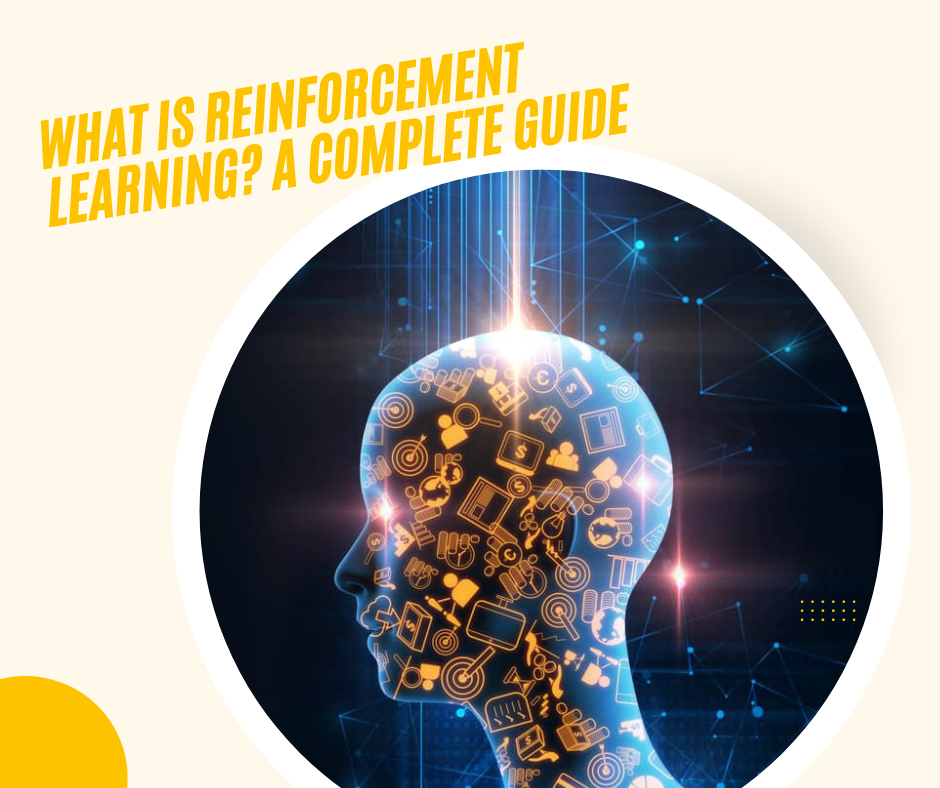What is Reinforcement Learning? A Complete Guide
 Ruhi Parveen
Ruhi Parveen
Introduction to Reinforcement Learning
Reinforcement Learning (RL) is a kind of machine learning where an agent learns how to make decisions by interacting with its environment. Unlike supervised learning, where the model learns from a labeled dataset, or unsupervised learning, where the model identifies patterns in data without explicit labels, reinforcement learning focuses on learning through trial and error. The agent receives feedback in the form of rewards or penalties based on the actions it takes, and its goal is to maximize the cumulative reward over time.
The Core Concepts of Reinforcement Learning
To understand reinforcement learning, it's essential to grasp the fundamental concepts:
- Agent: The decision-maker that interacts with the environment. The agent takes actions in an attempt to achieve the highest possible reward.
- Environment: The environment is the external system that the agent interacts with. It reacts to the agent's actions and gives feedback through rewards or penalties.
- State: A representation of the current situation or setup of the environment is called a state.The state provides the context in which the agent makes decisions.
- Action: The options available to the agent at any given state are called actions. The agent selects actions based on a policy to maximize rewards.
- Reward: The feedback the agent gets from the environment after taking an action is called a reward.Positive rewards encourage certain behaviors, while negative rewards (penalties) discourage them.
- Policy: A strategy or rule that the agent follows to choose actions based on the current state. Policies can be deterministic (specific action for each state) or stochastic (probabilistic action selection).
- Value Function: A function that estimates the expected cumulative reward that can be obtained from a state or state-action pair. Value functions guide the agent in choosing actions that lead to long-term rewards.
- Q-Value (Action-Value) Function: Similar to the value function, but it specifically evaluates the expected cumulative reward for taking a particular action in a given state.
How Reinforcement Learning Works
Reinforcement learning operates through a cyclic process where the agent:
Observes the current state of the environment.
Selects an action based on its policy.
Performs the action in the environment.
Receives a reward (or penalty) from the environment.
This loop continues until a termination condition is met, such as reaching a maximum number of steps or achieving a satisfactory performance level.
Exploration vs. Exploitation
One of the main challenges in reinforcement learning is finding the right balance between exploring new options and using the options that are already known to work well:
Exploration: The agent tries new actions to discover their effects and potential rewards. Exploration is crucial for learning, especially in the early stages, but it involves uncertainty and the risk of low rewards.
Exploitation: The agent uses its current knowledge to select actions that it believes will yield the highest rewards. Exploitation maximizes immediate returns but may prevent the agent from discovering better strategies.
A common approach to balancing these two aspects is the epsilon-greedy strategy, where the agent mostly exploits known actions but occasionally explores new ones.
Types of Reinforcement Learning
There are several approaches to reinforcement learning, each with its own strengths and applications:
1. Model-Free vs. Model-Based RL
Model-Free RL: The agent learns directly from experience without building a model of the environment. It relies on trial and error to learn the optimal policy. Common techniques include Q-learning and Policy Gradient methods.
Model-Based RL: The agent builds a model of the environment, which it uses to simulate outcomes and plan actions. This approach can be more efficient in complex environments but requires accurate modeling.
2. Value-Based vs. Policy-Based RL
Value-Based RL: The agent learns a value function that estimates the expected rewards for each state or state-action pair.Q-learning is a popular value-based method.
Policy-Based RL: The agent directly learns a policy that maps states to actions. Policy Gradient methods, such as REINFORCE, are common in this category.
3. Q-Learning and Deep Q-Networks (DQNs)
Q-Learning: A model-free, value-based RL algorithm where the agent learns the Q-value function to estimate the expected reward for each action in a given state. Q-learning updates the Q-values iteratively based on the Bellman equation.
Deep Q-Networks (DQNs): An extension of Q-learning that uses deep neural networks to approximate the Q-value function. DQNs are particularly useful in environments with large or continuous state spaces, where traditional Q-learning would be infeasible.
4. Actor-Critic Methods
Actor-Critic methods combine value-based and policy-based approaches. The "actor" component learns the policy, while the "critic" component evaluates the policy by estimating the value function. This approach helps stabilize the learning process and is widely used in modern RL applications.
Applications of Reinforcement Learning
Reinforcement learning has a broad range of applications across various fields:
1. Robotics
In robotics, RL is used to teach robots to perform complex tasks such as navigation, object manipulation, and interaction with humans. For example, robots can learn to walk, pick up objects, or collaborate with humans in industrial settings.
2. Game Playing
One of the most famous applications of RL is in game playing. Algorithms like AlphaGo, which defeated world champions in the board game Go, use RL to develop strategies that surpass human expertise. RL is also applied in video games to create intelligent, adaptive opponents.
3. Autonomous Vehicles
Autonomous vehicles, such as self-driving cars, use reinforcement learning to navigate environments, avoid obstacles, and make decisions in real time. RL helps these vehicles learn safe and efficient driving behaviors through simulation and real-world testing.
4. Finance
In finance, RL is used to develop trading strategies, manage portfolios, and optimize financial decision-making. The ability of RL to adapt to changing market conditions makes it a valuable tool for maximizing returns and minimizing risks.
5. Healthcare
RL is applied in healthcare for personalized treatment plans, optimizing resource allocation, and improving patient outcomes. For example, RL can help develop adaptive treatment strategies that respond to a patient’s changing health status.
6. Natural Language Processing (NLP)
In NLP, RL is used to improve dialogue systems, such as chatbots, by optimizing their responses based on user interactions. RL can also enhance machine translation and text summarization by refining models through feedback.
Challenges and Limitations of Reinforcement Learning
While reinforcement learning has shown great promise, it also faces several challenges:
1. Sample Efficiency
Reinforcement learning often needs many interactions with the environment to learn effective strategies.This can be costly in terms of time and resources, especially in real-world applications.
2. Exploration-Exploitation Trade-Off
Finding the right balance between exploration and exploitation is challenging. Over-exploration can lead to wasted efforts, while over-exploitation can prevent the discovery of better strategies.
3. Scalability
Scaling RL algorithms to environments with large or continuous state and action spaces is difficult. Techniques like function approximation and deep learning help, but they introduce new challenges, such as stability and convergence issues.
4. Sparse Rewards
In many environments, rewards are sparse, meaning they occur infrequently or are delayed. Learning in such environments is challenging because the agent receives little feedback on its actions.
5. Ethical and Safety Concerns
As RL is applied in more critical and sensitive areas, such as healthcare and autonomous vehicles, ethical and safety concerns arise. Ensuring that RL agents make decisions that align with human values and safety standards is a significant challenge.
Future of Reinforcement Learning
The future of reinforcement learning looks promising, with ongoing research focused on addressing its current limitations and expanding its applications. Some emerging trends include:
1. Hierarchical Reinforcement Learning
Hierarchical RL involves breaking down complex tasks into simpler subtasks, each handled by a separate RL agent. This approach improves learning efficiency and scalability.
2. Multi-Agent Reinforcement Learning
In multi-agent RL, multiple agents interact within the same environment, learning to cooperate or compete. This area is particularly relevant for applications like autonomous vehicles and distributed systems.
3. Transfer Learning
Transfer learning in RL involves applying knowledge learned in one environment to a different but related environment. This approach can significantly reduce the time and data required to train RL agents in new settings.
4. Safe Reinforcement Learning
Safe RL focuses on ensuring that agents behave safely, even during the learning process. This is critical in applications where mistakes can have severe consequences, such as healthcare and autonomous driving.
Conclusion
Reinforcement learning is a powerful and versatile machine learning paradigm that enables agents to learn through interaction with their environment. While it presents several challenges, its potential applications in robotics, gaming, finance, healthcare, and more make it an exciting and rapidly evolving field. As research progresses, reinforcement learning is likely to play an increasingly significant role in advancing AI and transforming various industries. For those interested in mastering such advanced techniques, Machine Learning Training in Noida, Delhi, Mumbai, Indore, and other parts of India offers valuable opportunities to gain the skills needed to excel in this dynamic area.
Subscribe to my newsletter
Read articles from Ruhi Parveen directly inside your inbox. Subscribe to the newsletter, and don't miss out.
Written by

Ruhi Parveen
Ruhi Parveen
I am a Digital Marketer and Content Marketing Specialist, I enjoy technical and non-technical writing. I enjoy learning something new.